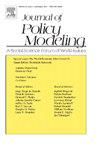Is Pakistan in a debt trap? Do domestic and foreign debts crowd-out private investment?
IF 3.1
2区 经济学
Q1 ECONOMICS
引用次数: 0
Abstract
Historically, Pakistan remained heavily dependent on domestic and external sources of financing which have strangled economic activities. Excessive public borrowing from domestic sources puts upward pressure on interest rates which crowded out domestic investment. Earlier studies found a linear relationship between debt and private investment. However, these studies overlooked the non-linear behavior of debt. The present study fills the research gap by examining the asymmetric impact of domestic and external debt on private investment. Further, this study attempts to explore whether the domestic and foreign debt crowed-in or crowed-out private investment in Pakistan over the period from 1972 to 2022. To this end, the Non-linear Autoregressive Distributed Lag (NARDL) model has been utilized to capture the positive and negative shocks of domestic and foreign debt on private investment. The empirical outcome confirms the existence of both the long-run and short-run asymmetry between private investment, domestic debt, and external debt in Pakistan. Particularly, the positive shock to domestic debt deters private investment, while the negative shock promotes private investment in the short run. On the other hand, a positive shock to foreign debt enhances private investment in the short-run and the opposite holds for the negative shocks in the long-run. Another important finding is the crowding-out effect of public investment on private investment, which holds true in the short run. Thus, there is a need to curtail the size of domestic debt since its accumulation adversely affects private investment.
巴基斯坦陷入债务陷阱了吗?国内和国外债务会排挤私人投资吗?
从历史上看,巴基斯坦仍然严重依赖国内和外部资金来源,这扼杀了经济活动。过多的国内公共借款给利率带来了上行压力,挤掉了国内投资。早期的研究发现,债务和私人投资之间存在线性关系。然而,这些研究忽略了债务的非线性行为。本研究通过考察国内和外部债务对私人投资的不对称影响填补了研究空白。此外,本研究试图探讨在1972年至2022年期间,巴基斯坦的国内和国外债务是否挤占或挤占了私人投资。为此,非线性自回归分布滞后(NARDL)模型被用来捕捉国内和国外债务对私人投资的积极和消极冲击。实证结果证实,巴基斯坦私人投资、国内债务和外债之间存在长期和短期不对称。特别是,对国内债务的正面冲击阻碍了私人投资,而负面冲击在短期内促进了私人投资。另一方面,对外债的积极冲击在短期内促进了私人投资,而对长期的消极冲击则相反。另一个重要的发现是公共投资对私人投资的挤出效应,这在短期内是正确的。因此,有必要缩减国内债务的规模,因为其积累对私人投资产生不利影响。
本文章由计算机程序翻译,如有差异,请以英文原文为准。
求助全文
约1分钟内获得全文
求助全文
来源期刊

Journal of Policy Modeling
ECONOMICS-
CiteScore
6.20
自引率
11.40%
发文量
76
期刊介绍:
The Journal of Policy Modeling is published by Elsevier for the Society for Policy Modeling to provide a forum for analysis and debate concerning international policy issues. The journal addresses questions of critical import to the world community as a whole, and it focuses upon the economic, social, and political interdependencies between national and regional systems. This implies concern with international policies for the promotion of a better life for all human beings and, therefore, concentrates on improved methodological underpinnings for dealing with these problems.
 求助内容:
求助内容: 应助结果提醒方式:
应助结果提醒方式:


